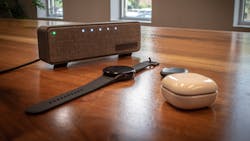RF Power Transmitter Ushers Over-the-Air Wireless Charging into Homes
Click for more CES 2023 coverage
Powercast will be at CES 2023 with its Ubiquity RF power transmitter, a device it hopes can make a pervasive presence of RF wireless power in smart homes. With this transmitter, Powercast claims to have lowered the barrier to entry into having multiple RF wireless power transmitters covering every home.
The idea of the Ubiquity transmitter is to make wireless charging a “set-and-forget” proposition, much like Wi-Fi. Powercast’s over-the-air wireless power architecture has two sides:
- A transmitter sends RF over the air
- A receiver embedded in end devices harvests that RF from the air and converts it into dc (direct current) to both communicate data and power devices.
On the transmitter side, Powercast’s Ubiquity will come in several forms, all able to both charge RF-enabled devices and communicate data back and forth with them throughout a home. Manufacturers have two options to turn their own products—such as home appliances, TVs, game systems, computer monitors or AI-enabled home assistants—into Ubiquity RF transmitters:
- A licensable reference design provides flexibility and ultimate cost savings for manufacturers to integrate just the electronics needed onto their own circuit boards for $5 or less bill-of-materials (BOM) cost.
- An easy-to-integrate, drop-in embeddable module contains all the electronics and hardware needed. Manufacturers will add a power supply and antenna. Powercast will work with manufacturers on an antenna design that best fits their specific product size.
On the receiving side, manufacturers can embed Powercast’s tiny Powerharvester PCC110 receiver chip and a small antenna into their end devices for around $1 to enable them to work with an RF transmitter—either Powercast’s standalone Ubiquity, or RF-transmitting products created using the Ubiquity embeddable module or reference design.
This wireless power-over-distance architecture is perfect for charging low-power devices with continuous, reliable, background trickle charging. End device examples include TV remotes, electric toothbrushes, keyboards and mice, game controllers, earbuds, headphones, smart watches, fitness bands, hearing aids, clocks, electric shavers, home automation devices and many more devices.
The Ubiquity transmitter can output up to 1 W (3 W EIRP) and automatically charges multiple RF-enabled devices that come into its charging zone, with no charging mats needed. Power-hungry devices charge faster within several feet of the transmitter, while ultra-low-power devices like IoT sensors can charge up to 120 feet.
The licensable Ubiquity reference design is expected in February 2023. The Ubiquity module and transmitter are expected in June 2023.
Ubiquity will be on display in Powercast’s booth #52311 at the Venetian Expo in the Smart Home Marketplace during CES 2023 in Las Vegas, January 5-8, 2023.
Click for more CES 2023 coverage
About the Author
David Maliniak
Executive Editor, Microwaves & RF
I am Executive Editor of Microwaves & RF, an all-digital publication that broadly covers all aspects of wireless communications. More particularly, we're keeping a close eye on technologies in the consumer-oriented 5G, 6G, IoT, M2M, and V2X markets, in which much of the wireless market's growth will occur in this decade and beyond. I work with a great team of editors to provide engineers, developers, and technical managers with interesting and useful articles and videos on a regular basis. Check out our free newsletters to see the latest content.
You can send press releases for new products for possible coverage on the website. I am also interested in receiving contributed articles for publishing on our website. Use our contributor's packet, in which you'll find an article template and lots more useful information on how to properly prepare content for us, and send to me along with a signed release form.
About me:
In his long career in the B2B electronics-industry media, David Maliniak has held editorial roles as both generalist and specialist. As Components Editor and, later, as Editor in Chief of EE Product News, David gained breadth of experience in covering the industry at large. In serving as EDA/Test and Measurement Technology Editor at Electronic Design, he developed deep insight into those complex areas of technology. Most recently, David worked in technical marketing communications at Teledyne LeCroy, leaving to rejoin the EOEM B2B publishing world in January 2020. David earned a B.A. in journalism at New York University.

